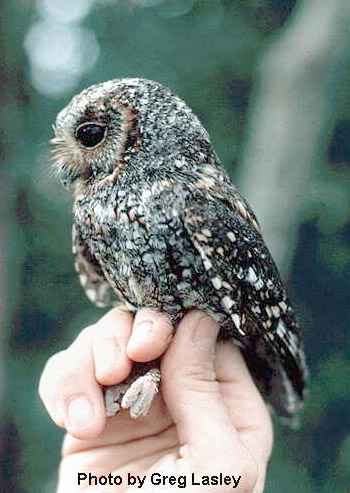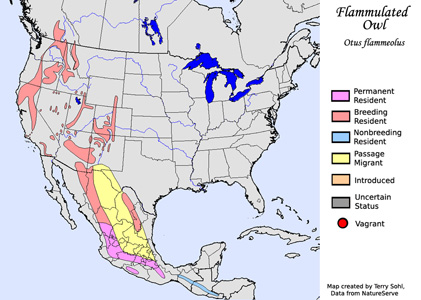| Length: 6.75 inches | Wingspan: 16 inches | Seasonality: Extremely rare visitor |
| ID Keys: Very small size, dark eyes, short ear tufts. | ||
 The
Flammulated Owl is the second smallest owl found in the United States, second
only to the Elf Owl of the
Southwestern U.S. They are found in coniferous forests of the west, where
they primarily pursue insects and spiders. They are difficult to observe
and their exact population status is unknown in many areas. They are very
closely related to screech owls, and appear very similar to them, other than
their distinctive dark eyes, smaller size, and shorter ear tufts.
The
Flammulated Owl is the second smallest owl found in the United States, second
only to the Elf Owl of the
Southwestern U.S. They are found in coniferous forests of the west, where
they primarily pursue insects and spiders. They are difficult to observe
and their exact population status is unknown in many areas. They are very
closely related to screech owls, and appear very similar to them, other than
their distinctive dark eyes, smaller size, and shorter ear tufts.
Habitat: Typically found in open conifer forests of mountain areas in the western U.S. They also can be found in aspen groves in some areas.
Diet: Feeds almost exclusively on large insects, especially moths, crickets, grasshoppers, and beetles, Also feeds on spiders. Unlike most owls, very rarely if ever feeds on vertebrates such as small mammals.
Behavior: Primarily forages by observing from a perch and flying out to capture insects when spotted, mostly by hovering and gleaning them from foliage and tree branches, but sometimes by catching them in mid-air.
Breeding: Non-breeder in South Dakota. In range, the nest is in a tree cavity, usually an old woodpecker hole. The female lays 2 or 3 eggs, and she alone incubates them while the male brings food. Once the eggs hatch, the female stays with the young at first while the male brings food to the family. The young fledge after about 4 weeks.
Song: Quiet soft hoot, often repeated every few seconds.
Migration: Found in suitable forest habitat throughout the western U.S. in summer months. Strongly migratory, with U.S. birds moving southward to Mexico or Central America for the winter.
Interactive eBird Map: Click here to access an interactive eBird map of Flammulated Owl sightings
Similar Species: Eastern Screech Owl
Conservation Status: Populations appear to be stable, with local declines where suitable forest has been destroyed.
Further Information: 1) USGS Patuxent Bird Identification InfoCenter, Flammulated Owl
3) Audubon Guide - Flammulated Owl
Photo Information: January 28th, 2006 - Photo from U.S. Geological Survey
| Click on the map below for a higher-resolution view |
 |
| South Dakota Status: Very rare visitor to South Dakota. |
Additional Flammulated Owl Photos (Coming Soon!)
